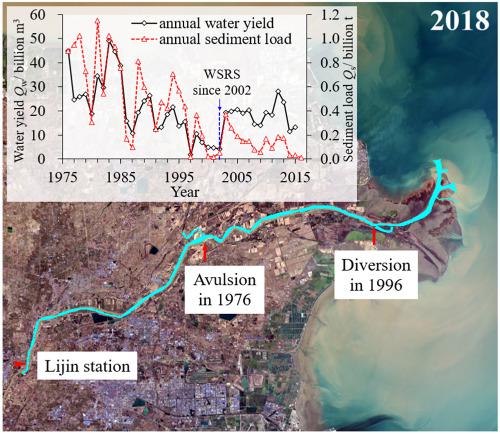当前位置:
X-MOL 学术
›
Earth Surf.Process. Land.
›
论文详情
Our official English website, www.x-mol.net, welcomes your
feedback! (Note: you will need to create a separate account there.)
Geomorphic evolution of the Qingshuigou channel of the Yellow River Delta in response to changing water and sediment regimes and human interventions
Earth Surface Processes and Landforms ( IF 2.8 ) Pub Date : 2020-06-14 , DOI: 10.1002/esp.4884 Shasha Han 1, 2 , Stephen Rice 3 , Guangming Tan 1 , Kairong Wang 2 , Shan Zheng 1
Earth Surface Processes and Landforms ( IF 2.8 ) Pub Date : 2020-06-14 , DOI: 10.1002/esp.4884 Shasha Han 1, 2 , Stephen Rice 3 , Guangming Tan 1 , Kairong Wang 2 , Shan Zheng 1
Affiliation

|
Delta channels are important landforms at the interface of sediment transfer from
terrestrial to oceanic realms and affect large, and often vulnerable, human populations.
Understanding these dynamics is pressing because delta processes are sensitive to
climate change and human activity via adjustments in, for example, mean sea level,
and water and sediment regime. Data collected over a 40-year period along a 110km
distributary channel of the Yellow River Delta offers an ideal opportunity to investigate
morphological responses to changing water and sediment regimes and intensive
human activity. Complementary data from the delta front provide an opportunity to
explore the interaction between delta channel geomorphology and delta-front erosionaccretion patterns. Cross-section dimensions and shape, longitudinal gradation and a
sediment budget are used to quantify spatial and temporal morphological change
along the Qingshuigou channel. Distinctive periods of channel change are identified,
and analysis provides a detailed understanding of the temporal and spatial
adjustments of the channel to specific human interventions, including two artificial
channel diversions and changes in water and sediment supply driven by river
management, and downstream delta-front development. Adjustments to the This article is protected by copyright. All rights reserved.
diversions included a short-lived period of erosion upstream and significant erosion in
the newly activated channel, which progressed downstream. Channel geomorphology
widened and deepened during periods when management increased water yield and
decreased sediment supply, and narrowed and shallowed during periods when
management reduced water yield and the sediment load. Changes along the channel
are driven by both upstream and downstream forcing. Finally, there is some evidence
that changing delta-front erosion-accretion patterns played an important role to the
geomorphic evolution of the deltaic channel; an area that requires further investigation.
中文翻译:

黄河三角洲清水沟河道地貌演化响应水沙情势变化和人为干预
三角洲河道是沉积物从陆地向海洋领域转移的界面处的重要地貌,影响着大量且通常是脆弱的人群。了解这些动态是紧迫的,因为三角洲过程对气候变化和人类活动很敏感,例如通过调整平均海平面、水和沉积物状况。沿黄河三角洲 110 公里分流河道收集的 40 年数据提供了一个理想的机会来研究形态对水和沉积物变化以及密集的人类活动的响应。来自三角洲前缘的补充数据为探索三角洲河道地貌与三角洲前缘侵蚀增生模式之间的相互作用提供了机会。横截面尺寸和形状,纵向级配和沉积物收支被用来量化沿清水沟河道的时空形态变化。识别航道变化的不同时期,分析提供对特定人类干预的航道时空调整的详细了解,包括两次人工改道以及由河流管理和下游三角洲前缘驱动的水和泥沙供应变化发展。对本文的调整受版权保护。版权所有。改道包括上游的短暂侵蚀和新激活的河道中的严重侵蚀,该河道向下游发展。在管理增加出水量和减少沉积物供应期间,河道地貌变宽和加深,在管理减少产水量和泥沙负荷期间变窄和变浅。沿河道的变化是由上游和下游的强迫驱动的。最后,有证据表明变化的三角洲前缘侵蚀-增生模式对三角洲河道地貌演化起到了重要作用;需要进一步调查的领域。
更新日期:2020-06-14
中文翻译:

黄河三角洲清水沟河道地貌演化响应水沙情势变化和人为干预
三角洲河道是沉积物从陆地向海洋领域转移的界面处的重要地貌,影响着大量且通常是脆弱的人群。了解这些动态是紧迫的,因为三角洲过程对气候变化和人类活动很敏感,例如通过调整平均海平面、水和沉积物状况。沿黄河三角洲 110 公里分流河道收集的 40 年数据提供了一个理想的机会来研究形态对水和沉积物变化以及密集的人类活动的响应。来自三角洲前缘的补充数据为探索三角洲河道地貌与三角洲前缘侵蚀增生模式之间的相互作用提供了机会。横截面尺寸和形状,纵向级配和沉积物收支被用来量化沿清水沟河道的时空形态变化。识别航道变化的不同时期,分析提供对特定人类干预的航道时空调整的详细了解,包括两次人工改道以及由河流管理和下游三角洲前缘驱动的水和泥沙供应变化发展。对本文的调整受版权保护。版权所有。改道包括上游的短暂侵蚀和新激活的河道中的严重侵蚀,该河道向下游发展。在管理增加出水量和减少沉积物供应期间,河道地貌变宽和加深,在管理减少产水量和泥沙负荷期间变窄和变浅。沿河道的变化是由上游和下游的强迫驱动的。最后,有证据表明变化的三角洲前缘侵蚀-增生模式对三角洲河道地貌演化起到了重要作用;需要进一步调查的领域。











































 京公网安备 11010802027423号
京公网安备 11010802027423号